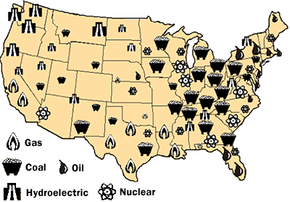The Power Plant
Electrical power starts at the power plant. In almost all cases, the power plant consists of a spinning electrical generator. Something has to spin that generator — it might be a water wheel in a hydroelectric dam, a large diesel engine or a gas turbine. But in most cases, the thing spinning the generator is a steam turbine. The steam might be created by burning coal, oil or natural gas. Or the steam may come from a nuclear reactor.
Electricity generation is the single largest source of greenhouse gas emissions in the United States [source: EPA]. That's why it's so important to develop more renewable sources of energy. In 2014, 67 percent of America's electricity came from fossil fuels like coal and natural gas. Hydroelectric energy was the largest renewable energy source, followed by solar, wind and geothermal power. In 2014, 6 percent of America's electricity was produced by hydropower, while solar, wind and thermal energy together comprised another 5 percent [source: EIA].
Advertisement
No matter what energy source spins the generator, commercial electrical generators of any size generate what is called 3-phase AC power. To understand 3-phase AC power, it is helpful to understand single-phase power first.
